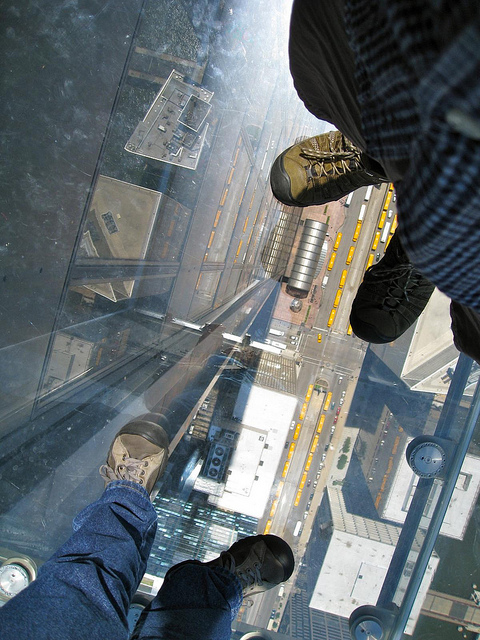A look back at – or down from? – Chicago’s observation decks
By Robin Amer

A look back at – or down from? – Chicago’s observation decks
By Robin Amer
Any number of disorders can be temporarily forgotten at such a height — a crime you committed long ago, a fatal error of judgment, even a secret berth of cancer cells — when you are rapt from yourself with such a view from the 102nd floor. Any amount of human queerness I mean to say, may be checked for a moment, as you face an Egyptian pyramid or a Sistine ceiling.
I silently inspected uncle, as he inspected his native city with that cobalt gaze of his. Empty factories, stilled freight yards, upended streets, stretches of river where the water was as still as a fish tank. And then the country side: prairies liberated from the darkness of the city, farmlands under white icing and skies suggesting freedom and eliciting ideas of flight or escape.
I wonder if uncle wasn’t thinking something like that: What a perfect day to flee.
Bellow’s Electronic Tower would seem to be a clear riff on Chicago’s Willis Tower (formerly the Sears Tower), with its expansive Sky Deck views at 1,353 feet, or perhaps the Hancock Building, with its similarly impressive and frightening tableaus (though Bellow makes no mention of a strange, waxy ice skating rink in miniature, which one can also find near the top of the Hancock).
The feelings Bellow describes may be similarly familiar to Chicagoans: City dwellers (and tourists) have always sought out the view from up high, for the way it literally changes our perspective, for the sense of the sublime it brings or for the reminder of our own relative smallness.
Tony Macaluso, an administrator at WFMT who developed a passion for skyscrapers during his seven years as a guide on Chicago’s well-known architectural boat tours, is writing the history of this pursuit. In a forthcoming book due out in 2014, he explores Chicago’s love for the tippy-top of tall buildings, starting with our observation decks. As it turns out, the Sky Deck has some pretty good antecedents in Chicago history.
As the pioneer of tall buildings, Chicago was also a pioneer of the miraculous urban vista, featuring some of the first and most posh observation decks in America.
“Chicago was at (the) forefront of this tourist trend,” Macaluso explained at a recent talk. “The same year the Eiffel Tower opened, barely six months later is when the Auditorium Building opened,” he said, referring to Adler and Sullivan landmark that’s now part of Roosevelt University. “That became the city’s first big observation deck. And the comparisons were actually pretty explicit in the press at the time between Chicago and Paris, the Auditorium Building and the Eiffel Tower, even though the Eiffel Tower was four times taller.”
In the audio above, Macaluso delves into the reactions provoked by the Auditorium Building’s observation deck. Anyone who has gazed down from the vantage of Willis Tower’s Sky Deck will surely understand the particular mix of awe and fear the Auditorium Building inspired in 19th-century Chicagoans.
Dynamic Range showcases hidden gems unearthed from Chicago Amplified’s vast archive of public events and appears on weekends. Tony Macaluso spoke at an event presented by the Chicago Architecture Foundation earlier this month. Click here to hear the event in its entirety.